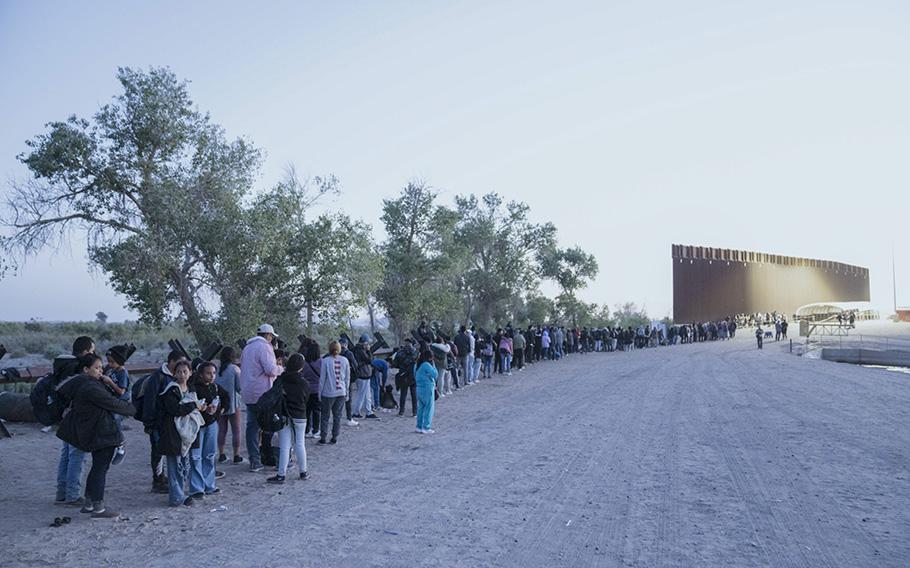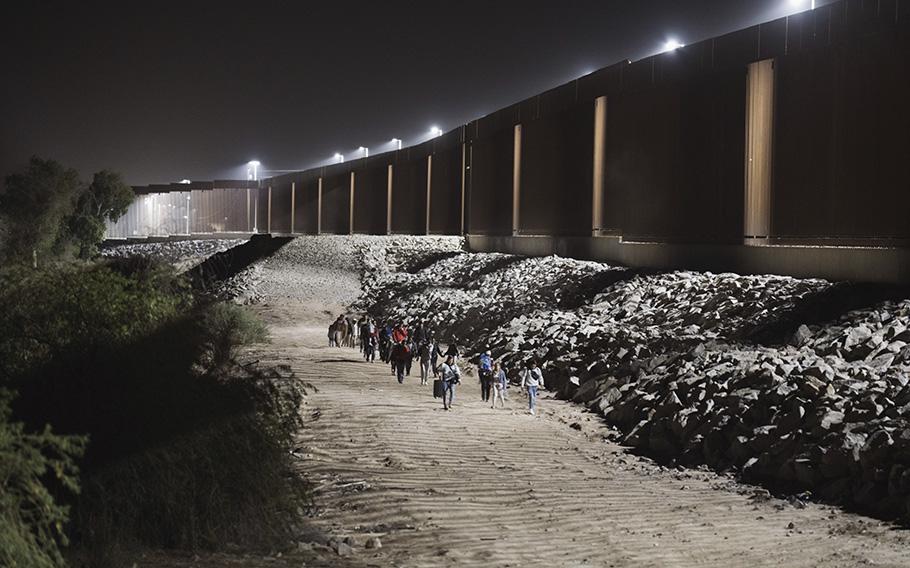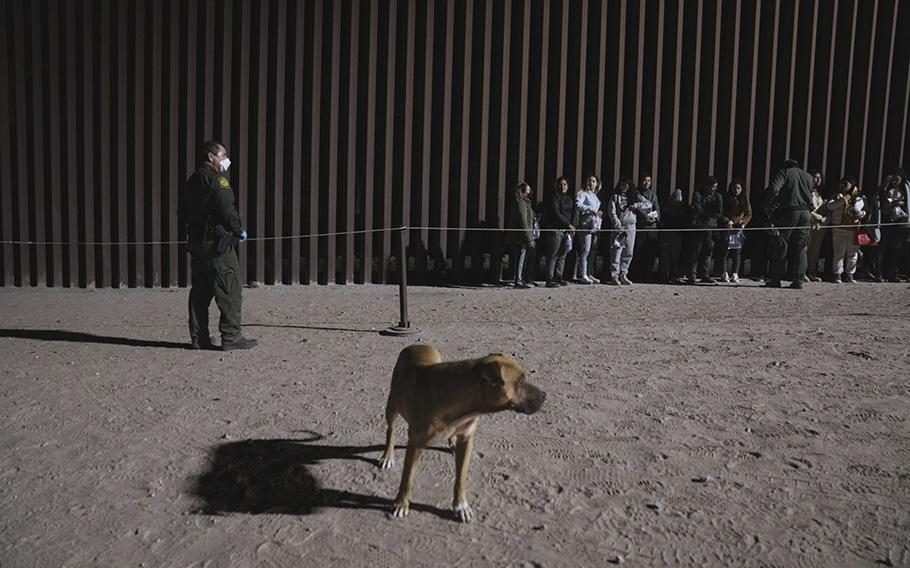
Migrants surrender to U.S. Border Patrol agents at the US-Mexico border in Yuma, Arizona, on May 11, 2023. (Eric Thayer/Bloomberg )
President Joe Biden wants to share the burden of an increase in migration with other nations along the path to the U.S. But the response in Latin America has been clear: This is a problem that requires U.S. policies and dollars to fix.
From Colombia to Mexico, the region is seeing sharp increases in migrants seeking to reach the U.S. as the Biden administration ends a pandemic-era policy known as Title 42 that allowed those who crossed the border without authorization to be swiftly deported. Latin American governments have been lobbying Washington for more humanitarian aid, funding to process asylum requests and long-term investment to shore up local economies and deter migration, but some leaders say assistance thus far has been lacking.
"We are stuck in the middle," Costa Rica President Rodrigo Chaves said in an interview this week. "We have talked a lot with the government of the United States, which is the final destination for most of these migrants, about them having to contribute, but we don't have a lot of hope."
U.S. officials have been seeing as many as 10,000 people a day at the southern border in recent days. Biden's plan to cope with the influx includes stepped up patrols, faster processing of migrants and a phone app to help with asylum requests - but it also calls for allies in Latin America to take on more of the burden. A new rule finalized this week allows the U.S. to deny asylum to many migrants who arrive at the border who didn't first seek protections in another country, such as Mexico, on their way to the U.S.
The policy could result in a huge increase in asylum cases in those countries, with Costa Rica already burdened by more than 220,000 refugee requests in the four years through November 2022, creating a massive backlog.
This week, a delegation from Mexico's government visited the White House and called for more money to address poverty and violence, seen as the root causes of migration in the region. President Andrés Manuel López Obrador spoke with Biden on a call about the need for cooperation to address conditions in the region. Miguel Meza, head of migrant programs for Catholic Relief Services, estimates there are 55,000 people in northern Mexico waiting to cross the U.S. border, hailing from Mexico, Central America, Venezuela, Haiti and other countries.
Many of those migrants traversed long routes by land or sea just to get to Mexico. Panama has seen a fivefold surge this year in U.S.-bound migrants, most of them Venezuelans but also Cubans, Ecuadorans and Chinese, crossing the Darien Gap, a dense jungle on the border between Colombia and Panama. Thousands are gathered in northwestern Colombia as they prepare to head to the U.S. through the jungle.

Migrants walks along the border fence before surrendering to U.S. Border Patrol agents, in Yuma, Arizona, on May 10, 2023. (Eric Thayer/Bloomberg )
In the first three months of 2023, more than 87,000 migrants entered Panama from Colombia, a 530% increase from the same period in 2022, according to Panama's immigration service. Foreign Affairs Minister Janaina Tewaney traveled to Washington this week to meet with lawmakers and U.S. diplomats, lobbying for "joint action to address the challenges posed by large flows of migrants."
Migrants arriving in Panama typically continue through Central America and Mexico on their way to the U.S., walking along highways or taking buses, trains or other public transportation. Many are traveling after a prolonged period of pandemic restrictions and as their countries have been slow to recover economically amid faster inflation.
Some of them end up staying and requesting refugee status in countries along the route, increasing costs for governments that must provide public services. Last year, thousands of Venezuelans were stranded in Costa Rica after the Biden administration changed its immigration policy to discourage asylum requests at the U.S. border. The surge of arrivals in Panama amid the end of Title 42 threatens to create additional burdens there.
Guatemala's government in April called on the international community to "increase regional cooperation and promote legal forms of migration" in anticipation of the end of Title 42. President Alejandro Giammattei said his government has requested help from the U.S. Department of Homeland Security to handle migrant flows.
U.S. Vice President Kamala Harris was tasked to work with Central American countries to address the root causes of migration. A White House official said the efforts have paved the way to reduce migration over time and that Harris has secured more than $4.2 billion in private-sector investment commitments from companies including Nestlé and Target. The U.S. has also pledged to increase aid to the region by $4 billion over four years, the official said.
U.S. Customs and Border Protection has apprehended more than 1.22 million people - some of them repeat crossers - at the southwest border in the first half of this fiscal year, which began in October. That rate is on pace to break last year's record of 2.38 million. The record numbers could cause a large backlog of people in Mexican border towns as migrants wait for appointments to be considered for asylum in the U.S., said Ari Sawyer, a U.S. border researcher at Human Rights Watch.
AMLO, as the Mexican president is called, said this week that he supported Biden's efforts to get a handle on immigration, and vowed his country would help. Mexico has agreed to accept expelled migrants from certain countries who do not qualify for asylum, for example. But AMLO also took the opportunity to repeat a frequent dig at his American counterpart for failing to devote enough effort to ease political tensions in the region, which he maintained would help stem immigration.

Migrants surrender to U.S. Border Patrol in Yuma, Arizona. (Eric Thayer/Bloomberg )
"What does the government of the United States have to do? I say it respectfully, but reach agreements with Venezuela, with Cuba, with all the countries," López Obrador told reporters. "How can it maintain harmony, peace, and tranquility if there are so many differences of opinion, if there's so much confrontation with the neighbors?"
Andres Ramirez, the head of Mexico's refugee office, said the government is already overwhelmed and will need assistance to handle the expected increase in migrants and asylum requests as the U.S. turns more people away or bans those who don't follow its new guidelines.
"A budget increase is absolutely necessary, but it's not clear that is going to happen," Ramirez said.
Meanwhile, authorities in Mexico and Central America are trying to deter migrants by warning of the dangers along the route to the U.S., where some migrants are kidnapped or extorted. Officials are also trying to dispel rumors spread by smugglers, known as coyotes, that the border is open now that Title 42 has expired. Coyotes often charge thousands of dollars for their services.
"The end of Title 42, as of today, doesn't mean the border is open," said Cindy Mariella, a deputy minister at El Salvador's foreign affairs office. "Don't be fooled by unscrupulous people trying to take advantage of the situation and make a profit."
Bloomberg's Jordan Fabian, Maya Averbuch, Oscar Medina and Leda Alvim contributed to this report.